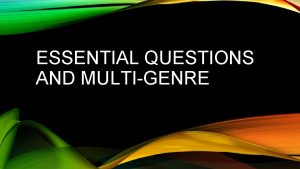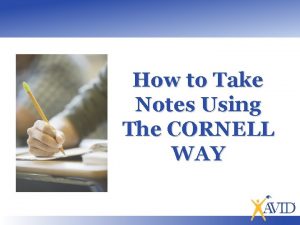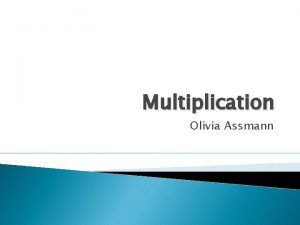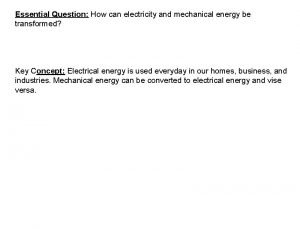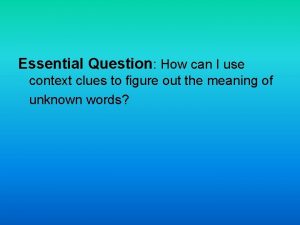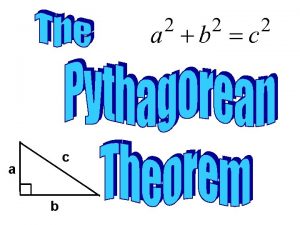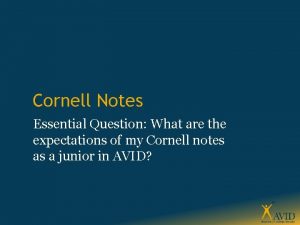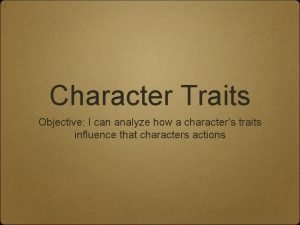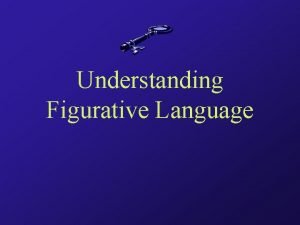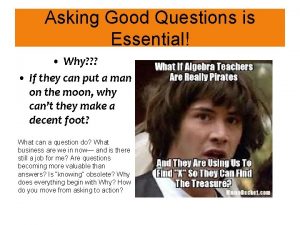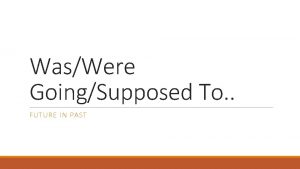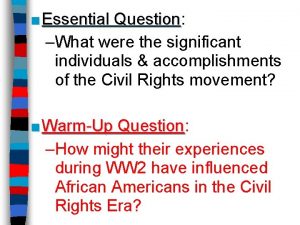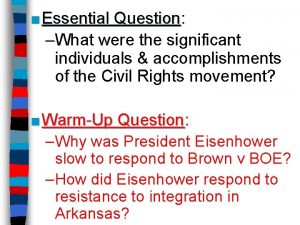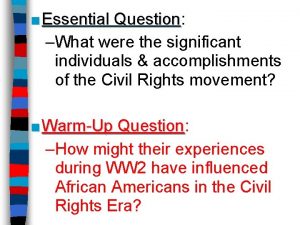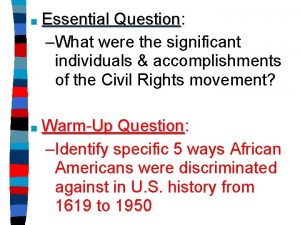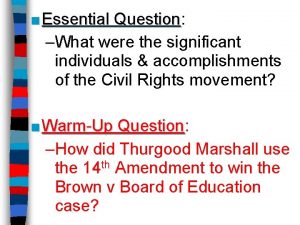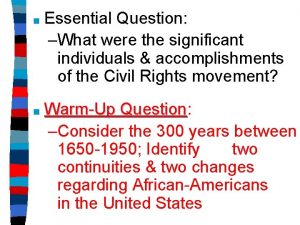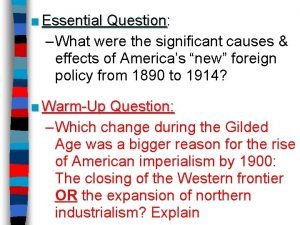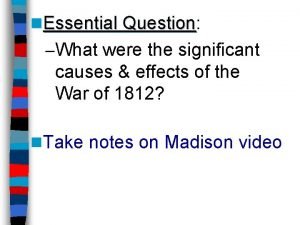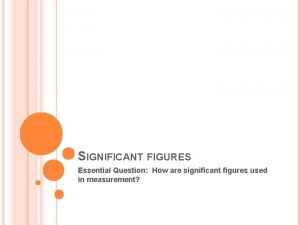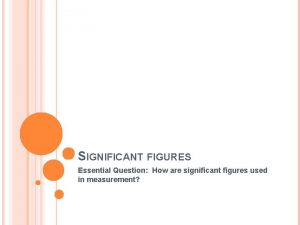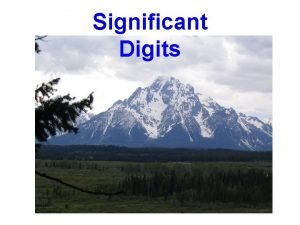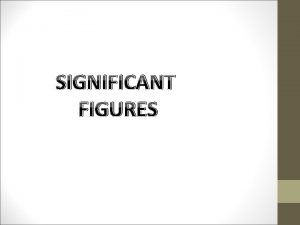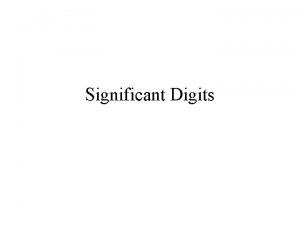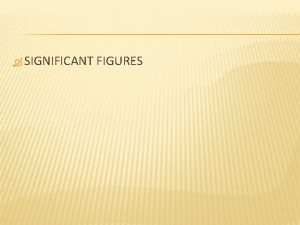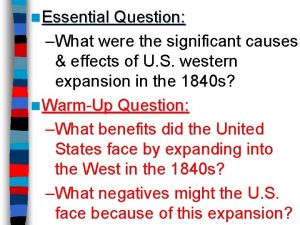Essential Question Question What were the significant individuals





































- Slides: 37

■ Essential Question: Question –What were the significant individuals & accomplishments of the Civil Rights movement? ■ Warm-Up Question: Question –Why was President Eisenhower slow to respond to Brown v BOE? –How did Eisenhower respond to resistance to integration in Arkansas?

Eyes on the Prize: An Introduction to Civil Rights Video (2. 21)

Civil Rights Movement, 1954 -1965 ■ In 1954, the Civil Rights movement began with the Brown v BOE decision, but the rest of American society remained segregated: –The NAACP showed that the 14 th Amendment could be used to challenge segregation –Civil rights leaders continued the fight for equality until segregation came to an end in 1965

The Montgomery Bus Boycott ■ In 1955, Rosa Parks’ arrest for disobeying an Alabama law requiring segregation on city buses sparked the Montgomery Bus Boycott –Minister Martin Luther King, Jr. organized a 381 -day boycott of the bus system to protest segregation –The boycott led to the integration of city buses & to the rise of MLK as the leader of black civil rights

Martin Luther King & the Montgomery Bus Boycott Video (5: 00)

Martin Luther King, Jr. ■ The success of the Montgomery Bus Boycott led MLK to form the Southern Christian Leadership Conference (SCLC) in 1957: –The SCLC was formed to use activism & non-violent protest to bring an end to segregation –The SCLC soon overtook the NAACP as the leading civil rights group in America

The SCLC was based on peaceful resistance & Christian Martin Luther King love: “We will meet your physical force & the SCLC with soul force. We will not hate you, but we will not obey your evil laws. We will wear you down by pure capacity to suffer. ”

Activism Through Non-Violent Protest ■ Martin Luther King’s non-violent approach inspired other groups to act: Non-Violent Protest Video (2: 00)

Activism Through Non-Violent Protest The 1960, “sit-in” students movement from NCnon-violent led A&T to led thea. Student sit-in at a ■In. Martin Luther King’s segregated Nonviolent lunch Coordinating counter Committee in Greensboro, NC approach inspired other groups(SNCC) to act:

Freedom faced. Non-Violent arrest &rode violence but Activism Through Protest In 1961 riders “Freedom Riders” buses exposed the lack of enforcement of ■ Martin Luther King’s non-violent throughout the South to test whether desegregation laws in the Deep South integration orders were being enforced approach inspired other groups to act:

March on Birmingham, 1963 ■ In 1963, MLK organized a march to integrate Birmingham, Alabama Birmingham, 1963 Video (2. 41)

March on Birmingham, 1963 ■ In 1963, MLK organized a march to integrate Birmingham, Alabama –Birmingham was considered the “most segregated city in America” –MLK’s strategy was to confront segregation through peaceful marches, rallies, & boycotts –Birmingham Police commissioner Bull Connor used violence to suppress the demonstrations

Violence in Birmingham, 1963

Violence in Birmingham, 1963 TV reports of the violence in Birmingham made it difficult for average Americans to ignore the plight of African Americans Public outrage over police brutality forced Birmingham officials to end segregation

During the march in Birmingham, MLK was arrested While in jail, MLK wrote an open letter called “Letter from a Birmingham Jail” in response to white Readwho excerpts from Martin Luther King’s leaders believed “Letter from a Birmingham Jail” & answer King was pushing too discussion questions provided on the fastthe towards civil rights chart on the back of your notes

Read excerpts from King’s “Letter from a Birmingham Jail”

■ Essential Question: Question –What were the significant individuals & accomplishments of the Civil Rights movement? ■ Warm-Up Question: Question –How did the strategies of the NAACP & Martin Luther King differ? –What was the significance of the Montgomery Bus Boycott in 1955?

Competing Voices of Civil Rights: Martin Luther King vs. Malcolm X ■ Compare the beliefs of civil rights leaders Martin Luther King, Jr. & Malcolm X: –Read the background information & take notes in the Venn diagram –Match the quotations provided with the appropriate author –When finished watch the video “Malcolm X on Martin Luther King” & prepare for a brief in-class discussion

“Malcolm X on Martin Luther King” Video (2. 24) As you watch the video look for 3 things Malcolm X says about Martin Luther King

“Martin Luther King on Malcolm X” Video (3. 32) As you watch the video look for 3 ways MLK defends himself from Malcolm X’s accusations

Class Discussion: Martin Luther King vs. Malcolm X 1. Why do you think there is so much antagonism between these 2 men? 2. In what ways were MLK & Malcolm X opposites? Did they share any common ground? 3. Is it possible that the 2 leaders may have converged, if not for their untimely deaths?

■ Essential Question: Question –What were the significant individuals & accomplishments of the Civil Rights movement? ■ Warm-Up Question: Question –How might the civil rights movement have gone differently if Malcolm X was the visible leader rather than MLK?

The Impact of Birmingham ■ The Birmingham march was a turning point in the Civil Rights movement: –The violence used by police revealed the need for gov’t action –TV broadcasted the events to a national audience

The those Impact of Birmingham, 1963 Among watching the violence on TV was President John F Kennedy who committed to a national civil rights act to end discrimination

March on Washington, 1963 ■ In 1963, civil rights leaders led a March on Washington to pressure Congress to pass a civil rights bill – 250, 000 people assembled in Washington DC to hear speakers including MLK March on Washington Video (1. 00)

“I Have a Dream” Speech, 1963 MLK delivered his “I Have a Dream” speech about a future without prejudice or racial segregation

The Civil Rights Act of 1964 ■ By 1963, the momentum of the civil rights movement caused President Kennedy to draft a civil rights bill that would outlaw all segregation: –In November 1963, JFK was assassinated in Dallas, Texas –VP Lyndon Johnson assumed the presidency & pushed the bill through Congress

The Civil Rights Act of 1964 ■ New president Lyndon Johnson signed the Civil Rights Act of 1964 –The law outlawed discrimination based on race, religion, & gender & ended most Jim Crow laws –The law integrated restaurants & hotels & gave the Justice Dept power to sue businesses that failed to comply with the law

In Alabama, had to Voting provide Rights Thevoters Need for written answers to a 20 -page test ■ Despite the success of the Civil on the Constitution & state gov’t Rights Act, African American leaders were not satisfied because the law did not protect voting rights –Southern state governments used literacy tests & poll taxes to restrict black citizens from voting –In most Southern states, less than half of eligible African Americans were registered to vote

The Need for Voting Rights ■ Civil rights leaders responded with new initiatives to bring voting rights

Freedom Summer, 1964 ■ Civil rights leaders responded with new Freedom Summer volunteers faced resistance; initiatives to bring voting rights 3 were murdered by KKK & local police –In 1964, white & black college students took part in Freedom Summer to help register African American voters in Mississippi

March in Selma, 1965 ■ Civil rights leaders responded with new initiatives to bring voting rights –In 1965, MLK organized a march in Selma, Alabama to protest voting restrictions –Police violence at Selma convinced President Johnson to push for a new federal voting law

The Voting Rights Act of 1965 ■ After the Selma march, LBJ signed the Voting Rights Act of 1965:

Civil Rights under LBJ ■ After the Selma march, LBJ signed the Voting Rights Act of 1965: –Banned literacy tests & sent federal voting officials into the South to protect voters –Voter registration & turnout increased among black citizens –African Americans elected black politicians for the 1 st time since Reconstruction (1865 -1877)


Conclusions ■ The Civil Rights movement of the 1950 s & 1960 s finally brought an end to segregation –African Americans gained protection of their voting rights –The Civil Rights movement inspired other minority groups to demand equality

“I Have a Dream” Analysis ■ What was the impact of the Civil Rights movement in America? –Listen to MLK’s “I Have a Dream” speech & identify the major points –Examine the data provided: To what extent was MLK’s dream a reality by the end of the 1960 s? –To what extent is MLK’s dream a reality today?
 Essential non essential fatty acids
Essential non essential fatty acids Costa questions
Costa questions Essential questions poetry
Essential questions poetry The cornell way
The cornell way Individual vs. society
Individual vs. society Essential questions for multiplication
Essential questions for multiplication Essential question generator
Essential question generator Context clues of essential
Context clues of essential Essential question gif
Essential question gif Essential questions for pythagorean theorem
Essential questions for pythagorean theorem Cornell notes essential question
Cornell notes essential question Essential questions about figurative language
Essential questions about figurative language Objective traits
Objective traits Figurative language essential questions
Figurative language essential questions Open-ended questions examples
Open-ended questions examples Essential question for pythagorean theorem
Essential question for pythagorean theorem Future in past
Future in past ưu thế lai là gì
ưu thế lai là gì Tư thế ngồi viết
Tư thế ngồi viết Thẻ vin
Thẻ vin Cái miệng nó xinh thế chỉ nói điều hay thôi
Cái miệng nó xinh thế chỉ nói điều hay thôi Các châu lục và đại dương trên thế giới
Các châu lục và đại dương trên thế giới Bổ thể
Bổ thể Từ ngữ thể hiện lòng nhân hậu
Từ ngữ thể hiện lòng nhân hậu Tư thế ngồi viết
Tư thế ngồi viết Thứ tự các dấu thăng giáng ở hóa biểu
Thứ tự các dấu thăng giáng ở hóa biểu Thơ thất ngôn tứ tuyệt đường luật
Thơ thất ngôn tứ tuyệt đường luật Alleluia hat len nguoi oi
Alleluia hat len nguoi oi Hươu thường đẻ mỗi lứa mấy con
Hươu thường đẻ mỗi lứa mấy con Diễn thế sinh thái là
Diễn thế sinh thái là đại từ thay thế
đại từ thay thế Vẽ hình chiếu vuông góc của vật thể sau
Vẽ hình chiếu vuông góc của vật thể sau 101012 bằng
101012 bằng Cong thức tính động năng
Cong thức tính động năng Tỉ lệ cơ thể trẻ em
Tỉ lệ cơ thể trẻ em Thế nào là mạng điện lắp đặt kiểu nổi
Thế nào là mạng điện lắp đặt kiểu nổi Lời thề hippocrates
Lời thề hippocrates Vẽ hình chiếu đứng bằng cạnh của vật thể
Vẽ hình chiếu đứng bằng cạnh của vật thể


